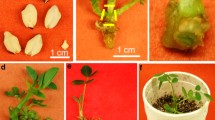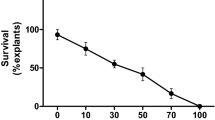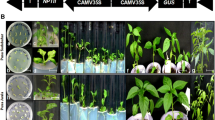Abstract
We have generated putative promoter tagged transgenic lines inArachis hypogaea cv JL-24 using cotyledonary node (CN) as an explant and a promoterless gus::nptII bifunctional fusion gene mediated byAgrobacterium transformation. MS medium fortified with 6-benzylaminopurine (BAP) at 4 mg/l in combination with 0.1 mg/l α-napthaleneacetic acid (NAA) was the most effective out of the various BAP and NAA combinations tested in multiple shoot bud formation. Parameters enhancing genetic transformation viz. seedling age,Agrobacterium genetic background and co-cultivation periods were studied by using the binary vector p35SGUSINT. Genetic transformation with CN explants from 6-day-old seedlings co-cultivated withAgrobacterium GV2260 strain for 3 days resulted in high kanamycin resistant shoot induction percentage (45%); approximately 31% transformation frequency was achieved with p35S GUSINT in Β-glucuronidase (GUS) assays. Among thein vivo GUS fusions studied with promoterless gus::nptII construct, GUS-positive sectors occupied 38% of the total transient GUS percentage. We have generated over 141 putative T0 plants by using the promoterless construct and transferred them to the field. Among these, 82 plants survived well in the green house and 5 plants corresponding to 3.54% showed stable integration of the fusion gene as evidenced by GUS, polymerase chain reaction (PCR) and Southern blot analyses. Twenty-four plants were positive for GUS showing either tissue-specific expression or blue spots in at least one plant part. The progeny of 15 T0 plants indicated Mendelian inheritance pattern of segregation for single-copy integration. The tissue-specific GUS expression patterns were more or less similar in both T0 and corresponding T1 progeny plants. We present the differential patterns of GUS expression identified in the putative promoter-tagged transgenic lines in the present communication.
Similar content being viewed by others
Abbreviations
- AMV:
-
Alfalfa mosaic virus
- BAP:
-
6-benzylaminophrine
- CN:
-
cotyledonary node
- GUS:
-
Β-glucuronidase
- NAA:
-
α-naphthaleneacetic acid
- PCR:
-
polymerase chain reaction
- RIM:
-
root induction medium
References
Andre D, Colau D, Schell J, Van Montagu M and Hernalsteens J P 1986 Gene tagging in plants by a T-DNA insertion that generates APH (3′) II plant gene fusions;Mol. Gen. Genet. 204 512–518
Bade J, Grinsven E, Custers J, Hoekstra S and Ponstein A 2003 T-DNA tagging inBrassica napus as an efficient tool for the isolation of new promoters for selectable marker genes;Plant Mol. Biol. 52 53–68
Bailey N T J 1965Statistical methods in biology (London: English Universities Press)
Bean S J, Gooding P S and Mullineaux P M 1997 A simple system for pea transformation;Plant Cell Rep. 16 513–519
Cheng M, Jarret R L, Li Z, Xing A and Demski J W 1996 Production of fertile transgenic peanut (Arachis hypogaea L.) plants usingAgrobacterium tumefaciens;Plant Cell Rep. 15 653–657
Datla R S S, Bekkaoui F, Hammerlindl J K, Pilate G, Dunstan D and Crosby W 1993 Improved high-level constitutive foreign gene expression in plants using an AMV RNA4 untranslated leader sequence;Plant Sci. 94 139–149
Datla R S S, Hammerlindl J, Pelcher L, Crosby W and Selvaraj G 1991 A bifunctional fusion between Β-glucuronidase and neomycin phosphotransferase: a broad spectrum marker enzyme for plants;Gene 101 2139–2246
Datla R, Anderson W and Selvaraj G 1997 Plant promoters for transgene expression; inBiotechnology annual review (ed) M R El-Gewely (Elsevier Science B V) pp 269–296
Doyle J J and Doyle J L 1987 A rapid DNA isolation procedure for small quantities of fresh leaf tissue;Phytochem. Bull. 19 11–15
Eapen S and George L 1994Agrobacterium tumefaciens-mediated gene transfer in peanut (Arachis hypogaea L.);Plant Cell Rep. 13 582–586
Egnin M, Mora A and Prakash C S 1998 Factors enhancingAgrobacterium tumefaciens-mediated gene transfer in Peanut (Arachis hypogaea L.);In Vitro Cell Dev. Biol. Plant 34 310–318
Fobert P, Labbe H, Cosmopulos J, McHugh S, Ouellet T, Hattori J, Sunohara G, Iyer V and Miki B 1994 T-DNA tagging of a seed coat-specific cryptic promoter in tobacco;Plant J. 6 567–577
Geetha N, Venkatachalam P and LakshmiSita G 1999 Agrobacterium-mediated genetic transformation of Pigeonpea (Cajanus cajan L.) and development of transgenic plants via Direct Organogenesis;Plant Biotechnol. 16 213–218
Gheysen G, Angenon G and Van Montagu M 1998 Agrobacterium mediated plant transformation: a scientifically intriguing story with significant applications; inTransgenic plant research (ed.) K Lindsey (Amsterdam: Harwood Academic Publishers) pp 1–33
Jaiwal P K, Kumari R, Ignacimuthu S, Potrykus I and Sautter C 2001Agrobacterium tumefaciens-mediated genetic transformation of mungbean (Vigna radiata L.Wilczek): a recalcitrant grain legume;Plant Sci. 161 239–247
Jefferson R A, Kavanagh T A and Bevan M W 1987 GUS fusion: Β-glucuronidase as a sensitive and versatile gene fusion marker in higher plants;EMBO J. 6 3901–3907
Kertbundit S, De DeGreve H, Deboeck B, Montagu M V and Hernalsteens J 1991In Vivo random Β -glucuronidase gene fusions inArabidopsis thaliana;Proc. Natl. Acad. Sci. USA 88 5212–5216
Koncz C, Martini N, Mayerhoffer B, Koncz-Kalman Z, Korber H, Redei G and Schell J 1989 High-frequency T-DNA tagging in plants;Proc. Natl. Acad. Sci. USA 86 8467–8471
Lindsey K, Wei W, Clarke M C, McArdle H F, Rooke L M and Topping J F 1993 Tagging genomic sequences that direct transgene expression by activation of a promoter trap in plants;Transgenic Res. 2 33–47
Murashige T and Skoog F A 1962 A revised medium for rapid growth and bioassays with tobacco tissue cultures;Plant Physiol. 15 473–497
Olhoft P M, Flagel L E, Donovan C M and Somers D A 2003 Efficient soybean transformation using hygromycin B selection in the cotyledonary-node method;Planta 216 723–735
Saini R, Jaiwal S and Jaiwal P K 2003 Stable genetic transformation ofVigna mungo L.Hepper viaAgrobacterium tumefaciens;Plant Cell Rep. 21 851–859
Sambrook J, Fritsch E F and Maniatis T 1989Molecular cloning: A laboratory manual, 2nd edition (New York: Cold Spring Harbor Laboratory Press)
Scholte M, d’Erfurth I, Rippa S, Mondy S, Cosson V, Durand R Breda C, Trinh H, Ignacio-Rodriguez-Llorente, Kondorosi E 2002 T-DNA tagging in the model legumeMedicago truncatula allows efficient gene discovery;Mol. Breed. 10 203–215
Sharma K K and Anjaiah V 2000 An efficient method for the production of transgenic plants of peanut (Arachis hypogaea L.) throughAgrobacterium tumefaciens-mediated genetic transformation;Plant Sci. 159 7–19
Somers D A, Samac D A and Olhoft P M 2003 Recent advances in legume transformation;Plant Physiol. 131 892–899
Suntio T M and Teeri T 1994 A new bifunctional reporter gene forin vitro tagging of plant promoters;Plant Mol. Biol.Rep. 12 43–57
Teeri T, Estrella H, Depicker A, Van Montagu M and Palva E 1986 Identification of plant promotersin situ by T-DNA mediated transcriptional fusions to thenptII gene;EMBO J. 8 1755–1760
Townsend J A and Thomas L A 1993An improved method of Agrobacterium mediated Transformation of cultured soybean cells, Patent W094/02620
Topping J F, Agyeman F, Henricot B and Lindsey K 1994 Identification of molecular markers of embryogenesis inArabidopsis thaliana by promoter trapping;Plant J. 5 895–903
Vancanneyt G, Schmidt R and O’ Connor-Sanchez A, Willmitzer L and Rocha-Sosa M 1990 Construction of an intron-containing marker gene: splicing of the intron in transgenic and its use in monitoring early events in Agrobacterium-mediated plant transformation;Mol. Gen.Genet. 220 24–250
Venkatachalam P, Geetha N, Khandelwal A, Shaila M S and LakshmiSita G 2000Agrobacterium-mediated genetic transformation and regeneration of transgenic plants from cotyledon explants of groundnut (Arachis hypogaea L.) via somatic embryogenesis;Curr. Sci. 78 1130–1136
Walden R 2002 T-DNA tagging in a genomics era;Crit. Rev. Plant Sci. 21 143–165
Webb K J, Skot L, Nicolson M N, Jorgenson B and Mizen S 2000Mesorhizobium loti increases root-specific expression of a calcium-binding protein homologue identified by promoter tagging inLotus japonicus.Mol.Plant Microbe Interact. 13 606–616
Author information
Authors and Affiliations
Corresponding author
Rights and permissions
About this article
Cite this article
Anuradha, T.S., Jami, S.K., Datla, R.S. et al. Genetic transformation of peanut (Arachis hypogaea L.) using cotyledonary node as explant and a promoterlessgus::nptII fusion gene based vector. J Biosci 31, 235–246 (2006). https://doi.org/10.1007/BF02703916
Received:
Accepted:
Issue Date:
DOI: https://doi.org/10.1007/BF02703916




